air conditioning LINCOLN MKC 2015 Owners Manual
[x] Cancel search | Manufacturer: LINCOLN, Model Year: 2015, Model line: MKC, Model: LINCOLN MKC 2015Pages: 490, PDF Size: 4.74 MB
Page 11 of 490
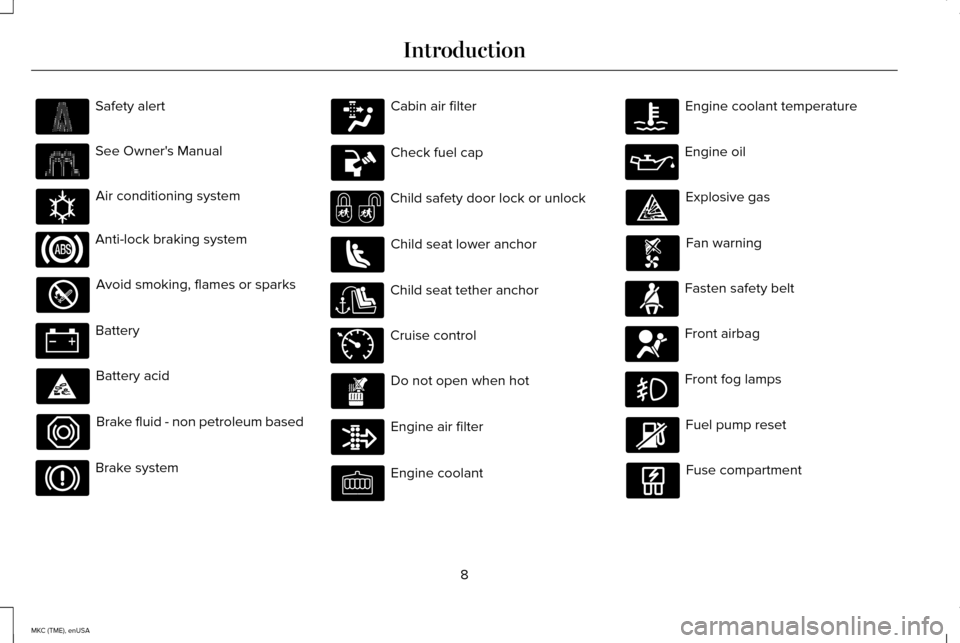
Safety alert
See Owner's Manual
Air conditioning system
Anti-lock braking system
Avoid smoking, flames or sparks
Battery
Battery acid
Brake fluid - non petroleum based
Brake system Cabin air filter
Check fuel cap
Child safety door lock or unlock
Child seat lower anchor
Child seat tether anchor
Cruise control
Do not open when hot
Engine air filter
Engine coolant Engine coolant temperature
Engine oil
Explosive gas
Fan warning
Fasten safety belt
Front airbag
Front fog lamps
Fuel pump reset
Fuse compartment
8
MKC (TME), enUSA Introduction E162384 E71340
Page 140 of 490
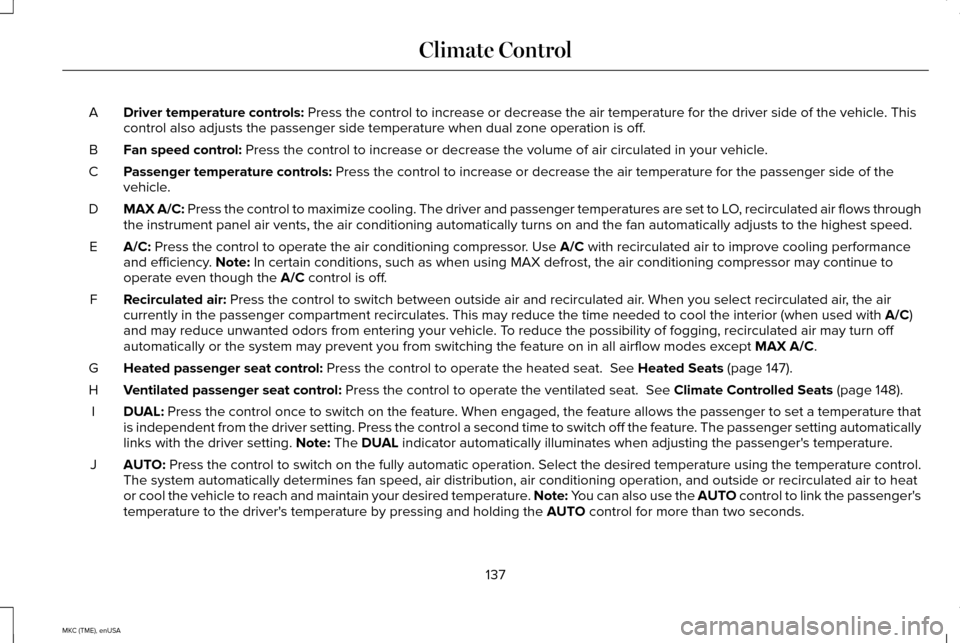
Driver temperature controls: Press the control to increase or decrease the air temperature for the d\
river side of the vehicle. This
control also adjusts the passenger side temperature when dual zone opera\
tion is off.
A
Fan speed control:
Press the control to increase or decrease the volume of air circulated \
in your vehicle.
B
Passenger temperature controls:
Press the control to increase or decrease the air temperature for the p\
assenger side of the
vehicle.
C
MAX A/C: Press the control to maximize cooling. The driver and passenger tempera\
tures are set to LO, recirculated air flows through
the instrument panel air vents, the air conditioning automatically turns\
on and the fan automatically adjusts to the highest speed.
D
A/C:
Press the control to operate the air conditioning compressor. Use A/C with recirculated air to improve cooling performance
and efficiency. Note: In certain conditions, such as when using MAX defrost, the air conditio\
ning compressor may continue to
operate even though the A/C control is off.
E
Recirculated air:
Press the control to switch between outside air and recirculated air. When you select recirculated air, the air
currently in the passenger compartment recirculates. This may reduce the\
time needed to cool the interior (when used with A/C)
and may reduce unwanted odors from entering your vehicle. To reduce the possibility of fogging, recirculated air may turn off
automatically or the system may prevent you from switching the feature o\
n in all airflow modes except
MAX A/C.
F
Heated passenger seat control:
Press the control to operate the heated seat. See Heated Seats (page 147).
G
Ventilated passenger seat control:
Press the control to operate the ventilated seat. See Climate Controlled Seats (page 148).
H
DUAL:
Press the control once to switch on the feature. When engaged, the feature allows the passenger to set a temperature th\
at
is independent from the driver setting. Press the control a second time \
to switch off the feature. The passenger setting automatically
links with the driver setting.
Note: The DUAL indicator automatically illuminates when adjusting the passenger's temperature.
I
AUTO:
Press the control to switch on the fully automatic operation. Select th\
e desired temperature using the temperature control.
The system automatically determines fan speed, air distribution, air con\
ditioning operation, and outside or recirculated air to heat
or cool the vehicle to reach and maintain your desired temperature.
Note: You can also use the AUTO control to link the passenger's
temperature to the driver's temperature by pressing and holding the AUTO control for more than two seconds.
J
137
MKC (TME), enUSA Climate Control
Page 181 of 490
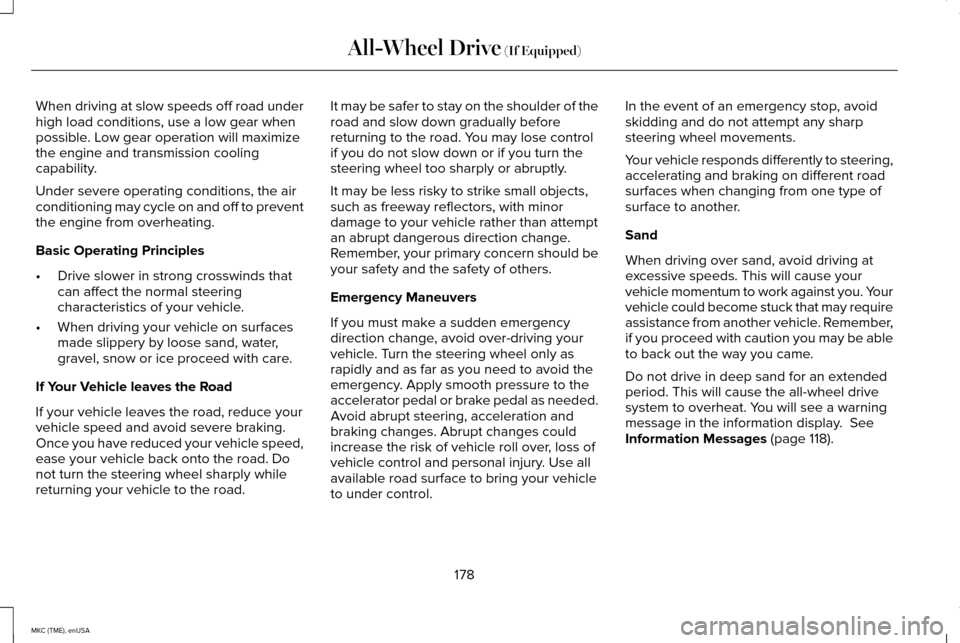
When driving at slow speeds off road under
high load conditions, use a low gear when
possible. Low gear operation will maximize
the engine and transmission cooling
capability.
Under severe operating conditions, the air
conditioning may cycle on and off to prevent
the engine from overheating.
Basic Operating Principles
•
Drive slower in strong crosswinds that
can affect the normal steering
characteristics of your vehicle.
• When driving your vehicle on surfaces
made slippery by loose sand, water,
gravel, snow or ice proceed with care.
If Your Vehicle leaves the Road
If your vehicle leaves the road, reduce your
vehicle speed and avoid severe braking.
Once you have reduced your vehicle speed,
ease your vehicle back onto the road. Do
not turn the steering wheel sharply while
returning your vehicle to the road. It may be safer to stay on the shoulder of the
road and slow down gradually before
returning to the road. You may lose control
if you do not slow down or if you turn the
steering wheel too sharply or abruptly.
It may be less risky to strike small objects,
such as freeway reflectors, with minor
damage to your vehicle rather than attempt
an abrupt dangerous direction change.
Remember, your primary concern should be
your safety and the safety of others.
Emergency Maneuvers
If you must make a sudden emergency
direction change, avoid over-driving your
vehicle. Turn the steering wheel only as
rapidly and as far as you need to avoid the
emergency. Apply smooth pressure to the
accelerator pedal or brake pedal as needed.
Avoid abrupt steering, acceleration and
braking changes. Abrupt changes could
increase the risk of vehicle roll over, loss of
vehicle control and personal injury. Use all
available road surface to bring your vehicle
to under control.In the event of an emergency stop, avoid
skidding and do not attempt any sharp
steering wheel movements.
Your vehicle responds differently to steering,
accelerating and braking on different road
surfaces when changing from one type of
surface to another.
Sand
When driving over sand, avoid driving at
excessive speeds. This will cause your
vehicle momentum to work against you. Your
vehicle could become stuck that may require
assistance from another vehicle. Remember,
if you proceed with caution you may be able
to back out the way you came.
Do not drive in deep sand for an extended
period. This will cause the all-wheel drive
system to overheat. You will see a warning
message in the information display. See
Information Messages (page 118).
178
MKC (TME), enUSA All-Wheel Drive
(If Equipped)
Page 267 of 490
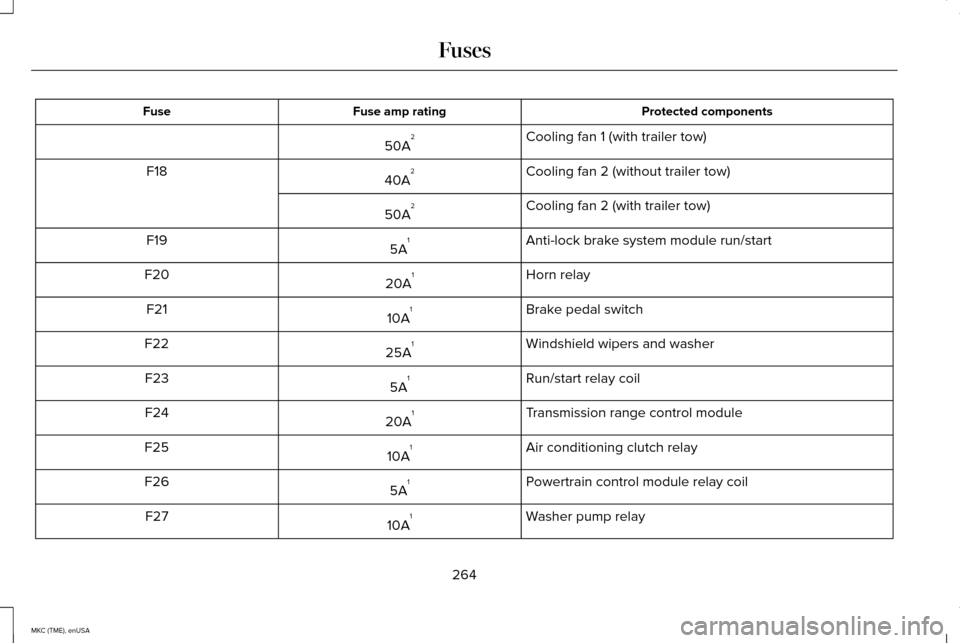
Protected components
Fuse amp rating
Fuse
Cooling fan 1 (with trailer tow)
50A 2
Cooling fan 2 (without trailer tow)
40A 2
F18
Cooling fan 2 (with trailer tow)
50A 2
Anti-lock brake system module run/start
5A 1
F19
Horn relay
20A 1
F20
Brake pedal switch
10A 1
F21
Windshield wipers and washer
25A 1
F22
Run/start relay coil
5A 1
F23
Transmission range control module
20A 1
F24
Air conditioning clutch relay
10A 1
F25
Powertrain control module relay coil
5A 1
F26
Washer pump relay
10A 1
F27
264
MKC (TME), enUSA Fuses
Page 271 of 490

Circuits switched
Relay
Cooling fan relay 4 (with trailer tow)
R10
Air conditioning clutch
R11
Cooling fan relay 1 (with trailer tow)
R12
Cooling fan relay 3 (without trailer tow)
Cooling fan relay 2
R13
Powertrain control module
R14
Heated rear window
R15
Blower motor
R16
Passenger Compartment Fuse Box
The fuse panel is behind the lower end of
the glove box.
268
MKC (TME), enUSA Fuses
Page 290 of 490
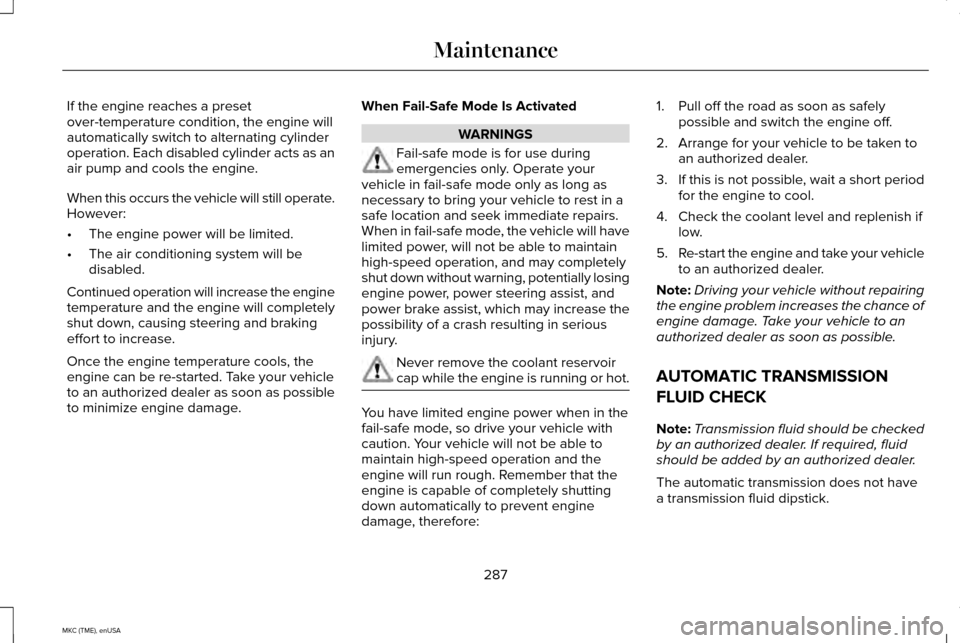
If the engine reaches a preset
over-temperature condition, the engine will
automatically switch to alternating cylinder
operation. Each disabled cylinder acts as an
air pump and cools the engine.
When this occurs the vehicle will still operate.
However:
•
The engine power will be limited.
• The air conditioning system will be
disabled.
Continued operation will increase the engine
temperature and the engine will completely
shut down, causing steering and braking
effort to increase.
Once the engine temperature cools, the
engine can be re-started. Take your vehicle
to an authorized dealer as soon as possible
to minimize engine damage. When Fail-Safe Mode Is Activated WARNINGS
Fail-safe mode is for use during
emergencies only. Operate your
vehicle in fail-safe mode only as long as
necessary to bring your vehicle to rest in a
safe location and seek immediate repairs.
When in fail-safe mode, the vehicle will have
limited power, will not be able to maintain
high-speed operation, and may completely
shut down without warning, potentially losing
engine power, power steering assist, and
power brake assist, which may increase the
possibility of a crash resulting in serious
injury. Never remove the coolant reservoir
cap while the engine is running or hot.
You have limited engine power when in the
fail-safe mode, so drive your vehicle with
caution. Your vehicle will not be able to
maintain high-speed operation and the
engine will run rough. Remember that the
engine is capable of completely shutting
down automatically to prevent engine
damage, therefore:1. Pull off the road as soon as safely
possible and switch the engine off.
2. Arrange for your vehicle to be taken to an authorized dealer.
3. If this is not possible, wait a short period
for the engine to cool.
4. Check the coolant level and replenish if low.
5. Re-start the engine and take your vehicle
to an authorized dealer.
Note: Driving your vehicle without repairing
the engine problem increases the chance of
engine damage. Take your vehicle to an
authorized dealer as soon as possible.
AUTOMATIC TRANSMISSION
FLUID CHECK
Note: Transmission fluid should be checked
by an authorized dealer. If required, fluid
should be added by an authorized dealer.
The automatic transmission does not have
a transmission fluid dipstick.
287
MKC (TME), enUSA Maintenance
Page 347 of 490

1
Ford recommends using Motorcraft (Ford) DOT 4 LV High Performance Brake Fluid or equivalent meeting WSS-M6C65-A2. Use of any fluid
other than the recommended fluid may cause degraded brake performance and not meet the Ford performance standards. Keep brake fluid
clean and dry. Contamination with dirt, water, petroleum products or other materials may result in brake system damage and possible failure.
2 Approximate dry fill capacity. Actual amount may vary during fluid changes.
3 Automatic transmissions that require Motorcraft MERCON LV transmission fluid should only use Motorcraft MERCON LV transmission fluid.
Use of any fluid other than the recommended fluid may cause transmission\
damage.
Change the automatic transmission fluid at the correct service interval.\
See Scheduled Maintenance (page 451).
4 See your authorized dealer for fluid level checking or filling.
5 Use of synthetic or synthetic blend motor oil is not mandatary. Your engine has been designed to use Motorcraft engine oils or equivalent\
oils that meet Ford’ s oil specification. It is also acceptable to use an engine oil of recom\
mended viscosity grade that meets API SN requirements
and displays the API Certification Mark for gasoline engines.
6 Do not use oils labeled as API SN unless the label also displays the API\
certification mark. These oils do not meet the requirements of your
vehicle's engine and emissions system.
7 Do not use supplemental engine oil additives. They are unnecessary and c\
ould lead to engine damage that is not covered by Ford’ s warranty.
8 Add the coolant type originally equipped in your vehicle.
9 See the Warning below: WARNING
The air conditioning refrigerant system contains refrigerant R-134a unde\
r high pressure. Opening the air conditioning refrigerant system
can cause personal injury. Have the air conditioning refrigerant system serviced only by qualifie\
d personnel.
344
MKC (TME), enUSA Capacities and Specifications
Page 419 of 490
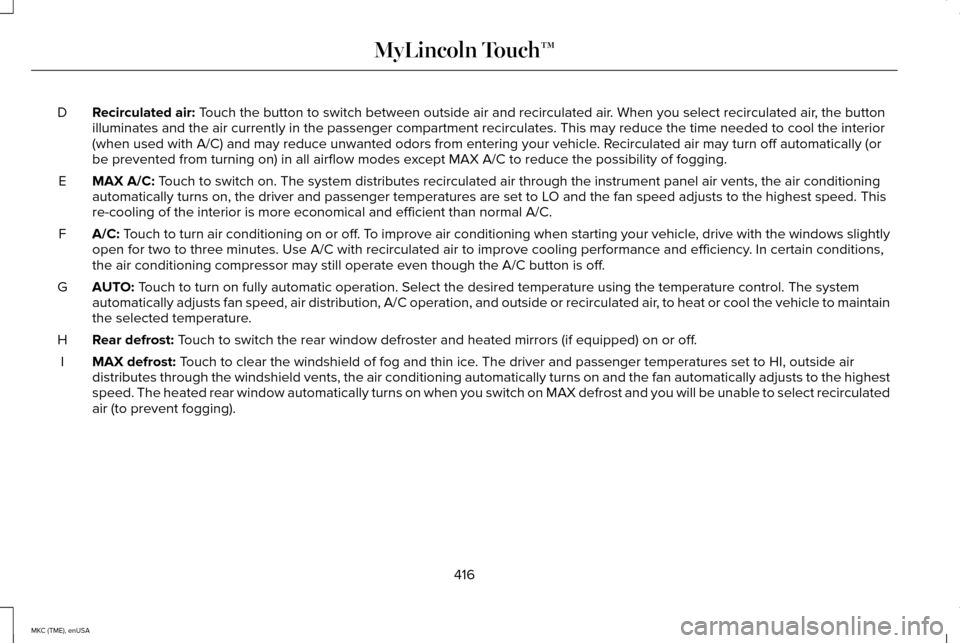
Recirculated air: Touch the button to switch between outside air and recirculated air. When you select recirculated air, the button
illuminates and the air currently in the passenger compartment recircula\
tes. This may reduce the time needed to cool the interior
(when used with A/C) and may reduce unwanted odors from entering your \
vehicle. Recirculated air may turn off automatically (or
be prevented from turning on) in all airflow modes except MAX A/C to reduce the possibility of fogging.
D
MAX A/C:
Touch to switch on. The system distributes recirculated air through the i\
nstrument panel air vents, the air conditioning
automatically turns on, the driver and passenger temperatures are set to\
LO and the fan speed adjusts to the highest speed. This
re-cooling of the interior is more economical and efficient than normal \
A/C.
E
A/C:
Touch to turn air conditioning on or off. To improve air conditioning when starting your vehicle, drive with the windows slightly
open for two to three minutes. Use A/C with recirculated air to improve \
cooling performance and efficiency. In certain conditions,
the air conditioning compressor may still operate even though the A/C bu\
tton is off.
F
AUTO:
Touch to turn on fully automatic operation. Select the desired temperatur\
e using the temperature control. The system
automatically adjusts fan speed, air distribution, A/C operation, and ou\
tside or recirculated air, to heat or cool the vehicle to maintain
the selected temperature.
G
Rear defrost:
Touch to switch the rear window defroster and heated mirrors (if equippe\
d) on or off.
H
MAX defrost:
Touch to clear the windshield of fog and thin ice. The driver and passenger temperatures set to HI, outside air
distributes through the windshield vents, the air conditioning automatic\
ally turns on and the fan automatically adjusts to the highest
speed. The heated rear window automatically turns on when you switch on \
MAX defrost and you will be unable to select recirculated
air (to prevent fogging).
I
416
MKC (TME), enUSA MyLincoln Touch™
Page 457 of 490
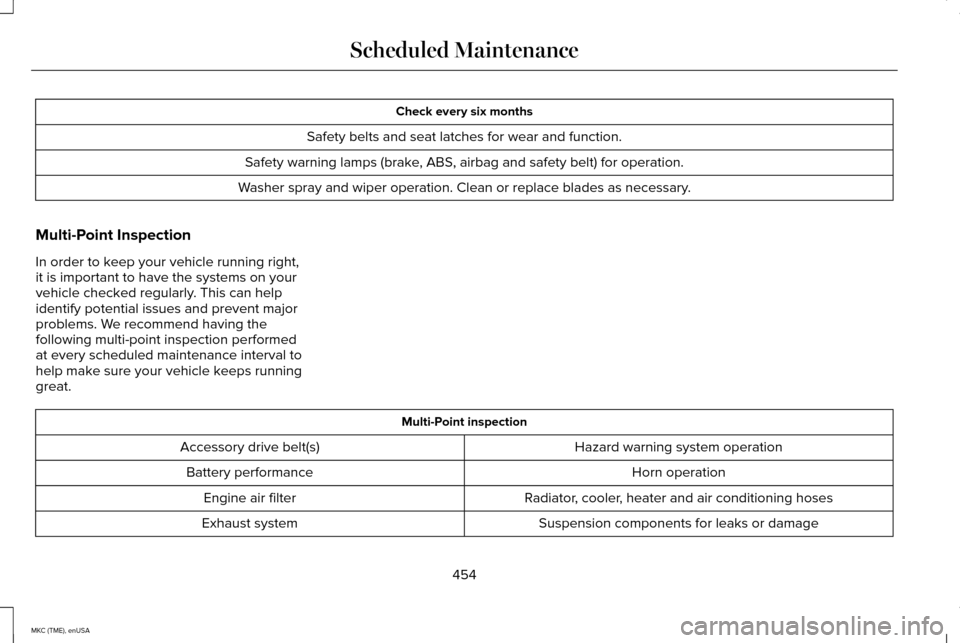
Check every six months
Safety belts and seat latches for wear and function.
Safety warning lamps (brake, ABS, airbag and safety belt) for operation.
Washer spray and wiper operation. Clean or replace blades as necessary.
Multi-Point Inspection
In order to keep your vehicle running right,
it is important to have the systems on your
vehicle checked regularly. This can help
identify potential issues and prevent major
problems. We recommend having the
following multi-point inspection performed
at every scheduled maintenance interval to
help make sure your vehicle keeps running
great. Multi-Point inspection
Hazard warning system operation
Accessory drive belt(s)
Horn operation
Battery performance
Radiator, cooler, heater and air conditioning hoses
Engine air filter
Suspension components for leaks or damage
Exhaust system
454
MKC (TME), enUSA Scheduled Maintenance
Page 478 of 490
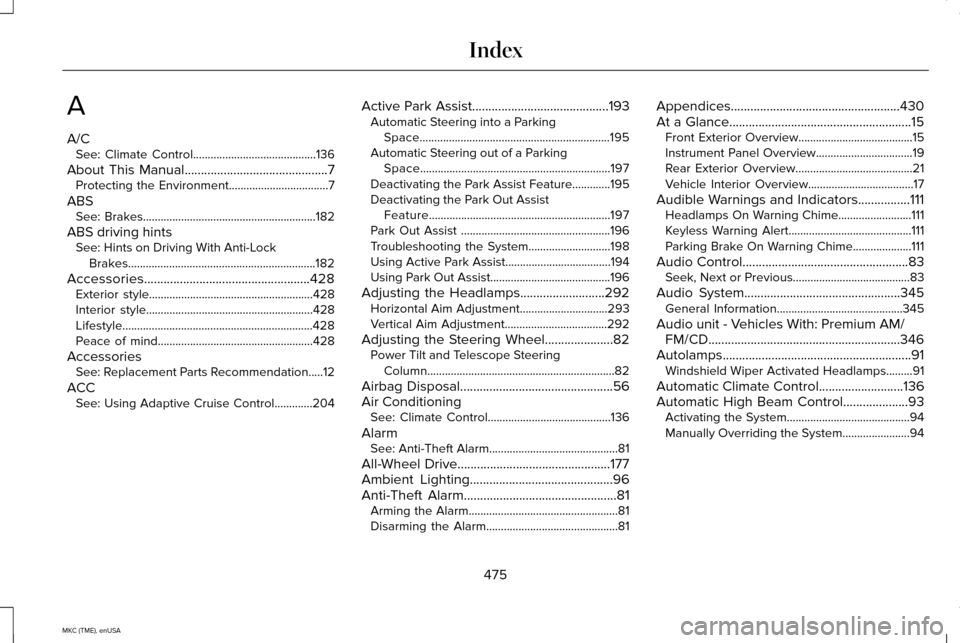
A
A/C
See: Climate Control..........................................136
About This Manual............................................7
Protecting the Environment..................................7
ABS See: Brakes...........................................................182
ABS driving hints See: Hints on Driving With Anti-Lock
Brakes................................................................182
Accessories...................................................428 Exterior style........................................................428
Interior style.........................................................428
Lifestyle.................................................................428
Peace of mind.....................................................428
Accessories See: Replacement Parts Recommendation.....12
ACC See: Using Adaptive Cruise Control.............204 Active Park Assist..........................................193
Automatic Steering into a Parking
Space.................................................................195
Automatic Steering out of a Parking Space.................................................................197
Deactivating the Park Assist Feature.............195
Deactivating the Park Out Assist Feature..............................................................197
Park Out Assist ...................................................196
Troubleshooting the System............................198
Using Active Park Assist....................................194
Using Park Out Assist.........................................196
Adjusting the Headlamps..........................292 Horizontal Aim Adjustment..............................
293
Vertical Aim Adjustment...................................292
Adjusting the Steering Wheel.....................82 Power Tilt and Telescope Steering
Column................................................................82
Airbag Disposal
...............................................56
Air Conditioning See: Climate Control..........................................136
Alarm See: Anti-Theft Alarm............................................81
All-Wheel Drive
...............................................177
Ambient Lighting............................................96
Anti-Theft Alarm
...............................................81
Arming the Alarm...................................................81
Disarming the Alarm.............................................81 Appendices....................................................430
At a Glance........................................................15
Front Exterior Overview.......................................15
Instrument Panel Overview.................................19
Rear Exterior Overview........................................21
Vehicle Interior Overview....................................17
Audible Warnings and Indicators................111 Headlamps On Warning Chime.........................111
Keyless Warning Alert..........................................111
Parking Brake On Warning Chime....................111
Audio Control
...................................................83
Seek, Next or Previous........................................83
Audio System................................................345 General Information...........................................345
Audio unit - Vehicles With: Premium AM/ FM/CD...........................................................346
Autolamps ..........................................................
91
Windshield Wiper Activated Headlamps.........91
Automatic Climate Control..........................136
Automatic High Beam Control....................93 Activating the System..........................................94
Manually Overriding the System.......................94
475
MKC (TME), enUSA Index